Zethyr Finance - Crypto Academy / S4W8 - Homework Post for @fredquantum
This is my homework post for Steemit Crypto Academy Season 4 Week 8 of Professor @fredquantum’s class Zethyr Finance.

Note : I performed this task on Windows 10 PC, Google Chrome.
Task 1 - What is Zethyr Finance?

Zethyr Finance is a dApp (decentralized application) built and operating on top of the TRON ecosystem. As the name implies, Zethyr Finance is a financial dApp. At Zethyr Finance each TRON account can borrow TRON asssets and lend their’s (TRC tokens and TRX) that will benefit them financially. The Whitepaper that can be downloaded here, noted that even though it is a decentralized exchange in nature, it also aggregates yield from centralized exchanges, beside of the decentralized ones. It is done to gain the best yield in aggregate across the market.
“Zethyr Finance is a TRON decentralised finance protocol, aggregating yields from both centralised and other decentralised protocols across the market for the best yields in aggregate.” Source: Zethyr Finance Whitepaper, which can be obtained or here
The TRON assets currently traded on Zethyr Finance, beside TRX, are BitTorrent (BTT), Tether USD (USDT), WINkLink (WIN). Any account that wants to lend its assets can put them on the exchange (called supplying). And every account that wants to borrow a certain amount of coins, is required to collateralize their supplies.
Important links:
- Website: https://zethyr.finance/#/
- Whitepaper: https://zethyr.finance/Zethyr-Whitepaper.pdf
- Blog on Medium: https://medium.com/@zethyrexchange
- Blog on Zethyr Exchange: https://blog.zethyr.exchange/
Social:
- Twitter Account: https://twitter.com/zethyrexchange
- Telegram Channel: https://t.me/ZethyrExchange

Task 2 - Zethyr Finance’s Features and DEX Aggregator
2.1. The Features of Zethyr Finance
2.1.1. Lending and Borrowing on Market
This is probably the main feature of Zethyr Finance. In the Market, TRON accounts can make transactions in the form of lending and borrowing, for their financial gain. Three basic steps to lending and borrowing assets on Zethyr Finance are: 1) Supplying, 2) Collateralizing, and 3) Borrowing. Every account which only supply the platforms will benefit related to the Supply APY of the supplied assets. While borrower will have to pay interest as much as the borrowed assets APY.
Below is the screenshot image of the Zethyr Finance Market interface.
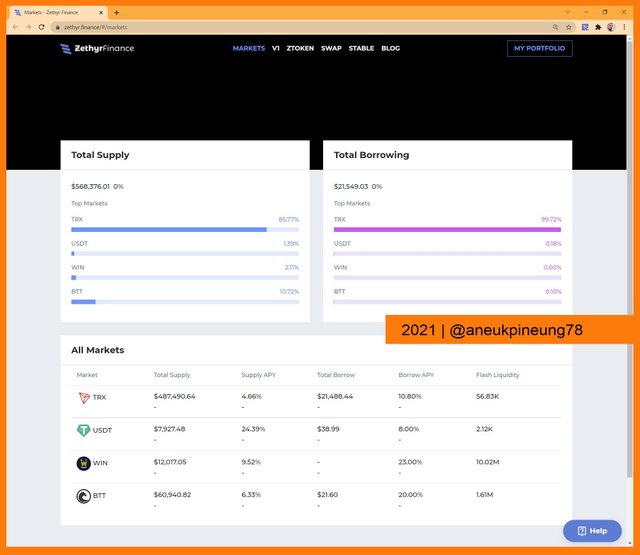
2.1.2. zToken
zTokens is a feature that accommodates assets supplied and/or collateralized to Zethyr Finance. Each zToken has a 1:1 value ratio with its underlying token. Every asset supplied in Zethyr Finance will be converted to zToken and sent to the supplier's account. A user who supplies 111 USDT will get 111zUSDT sent to his wallet. Each TRON asset currently available and accepted for trading on Zethyr Finance has its own zToken.
- zToken for USDT is zUSDT,
- zToken for TRX is zTRX,
- zToken for WIN is zWIN,
- zToken for BTT is zBTT.
zTokens are made with TRON’s TRC-20 coin standard.
Below is the screenshot image of the zToken webpage.
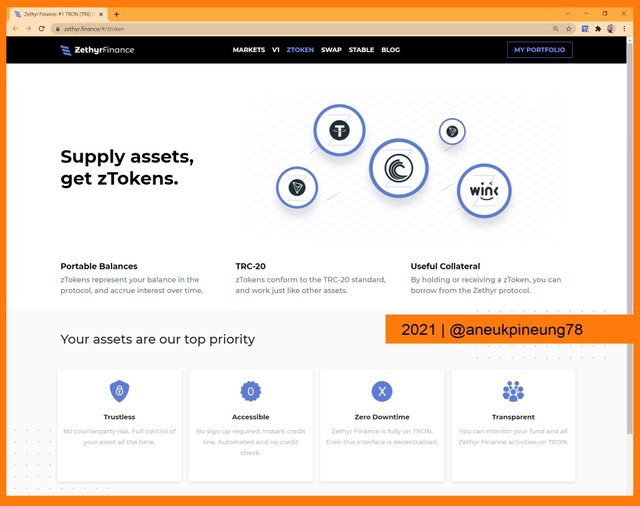
2.1.3. Swap on Exchange
On Zethyr Exchange,every TRON account can swap their TRON assets. Below is the screenshot image of the Zethyr Exchange webpage.
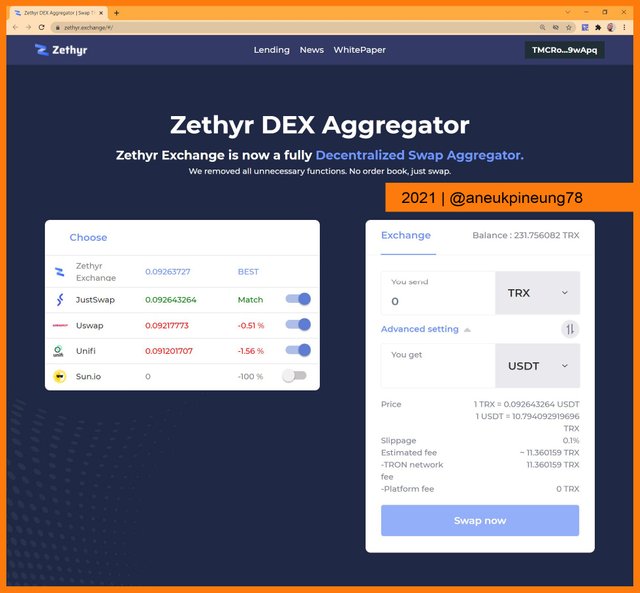
At time of writing, as much as 17 types of TRON assets are available and accepted for swap on Zethyr Exchange. They are (as shown on the picture below) : TRX, WIN, BTT, JST, SUNOLD, WBTT, zTRX, zBTT, zUSDT, 888, zWIN, USDJ, TUSD, UP, SUN, ETH, and BTC.
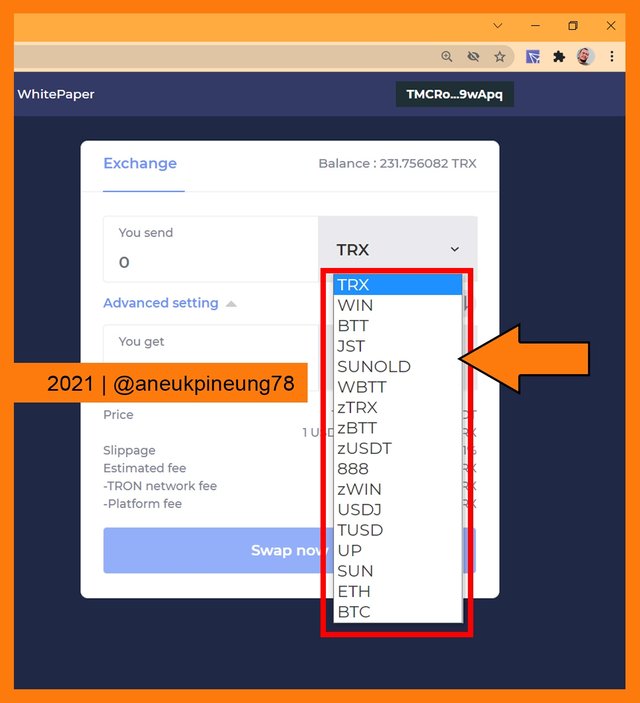
2.1.4. Stable Swap
In the Stable Swap feature, users can exchange USDT TRC-20 (TRON standard USDT) to USDT ERC-20 (Ethereum standard USDT). Swapping USDT TRC-20 to USDT ERC-20 on Zethyr's Stable Swap is very easy. The thing to do is to connect a wallet with the Stable Swap feature. Once its connected, Stable Swap will automatically detect the USDT balance in the wallet. The user can then enter the amount of USDT TRC-20 that he wants to convert to USDT ERC-20.
The things that Stable Swap promotes as advantages are:
- lowest fees,
- instantly,
- secure
- no registration,
- no deposit,
- no withdrawal, and
- 24/7 support at its Telegram channel
Stable Swap also promises:
- best rates on the market,
- fixed fee,
- only takes 1 - 3 minutes to complete a swap,
Below is the screenshot image of Stable Swap webpage.
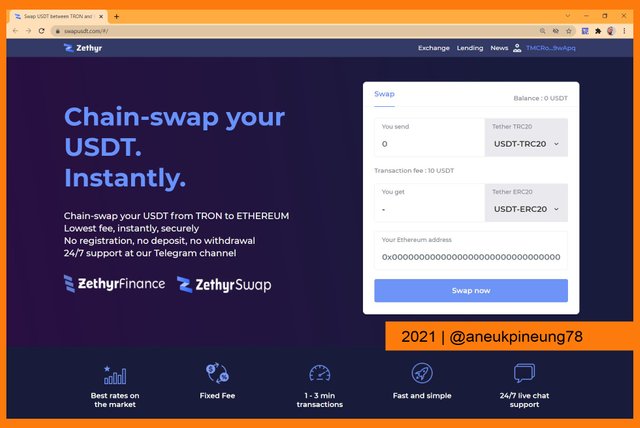
2.1.5. My Portfolio
My Portfolio is a summary page that records the details of an account's transactions, namely supply and borrow. Here is the screenshot image of my My Portfolio webpage.
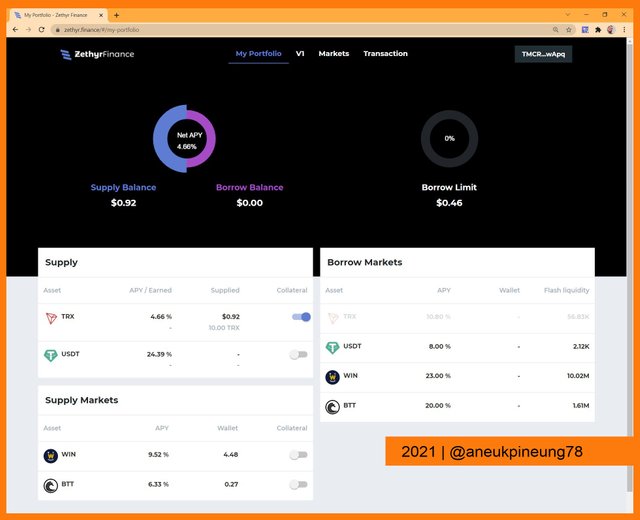
More detailed notes on wallet balances and each transaction that has been made can be seen on the Transactions page. Below is the screenshot image of the Transactions webpage.
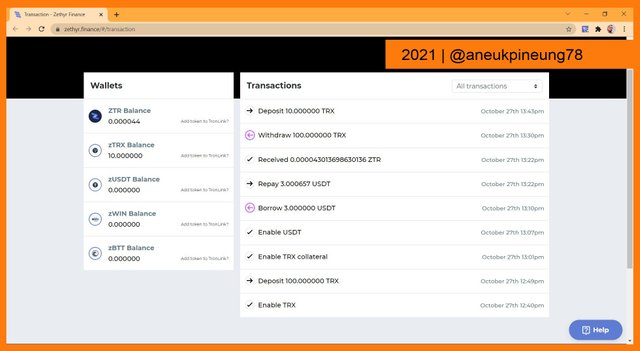
2.2. My Understanding About DEX Aggregator
DEX Aggregator is the result of the integration of two Zethyr technologies, Zethyr Exchange and Zethyr Swap. The official blog article entitled Zethyr Exchange has been integrated into Zethyr Swap which was uploaded on July 30th, 2021, stated that the integration of the two technologies was carried out after analyzing the behavior of market participants (dApp users) and evaluating Zethyr Exchange based on available data.
Zethyr DEX Aggregator can simply be interpreted as "Zethyr Exchange that adopts Swap technique". Swap is a token exchange technique that is simpler when compared to the methods used in traditional exchanges. By integrating Zethyr Finance and Zethyr Swap, a simpler exchange is obtained. The most important change is that in DEX Aggregator technology, thanks to swap technology, there is no need for the order book and its related functions.
With its DEX Aggregator technology, Zethyr Finance declared itself as “a fully decentralized swap aggregator”.
Apart from simplifying exchange functions by eliminating the order book and its related functions, Zethyr DEX Aggregator -as name implies- aggregates different DEXs and Swaps to give its users the best exchange rates to swap TRON tokens at best rates. And its zero fee, instantly swap TRON tokens. At time of writing, 4 applications have been aggregated successfully and 1 still in the process:
- Zethyr Exchange,
- JustSwap,
- USwap,
- Unifi,
- Sun.io (coming soon)
Below is the screenshot image of the Zethyr Exchange (DEX Aggregator).
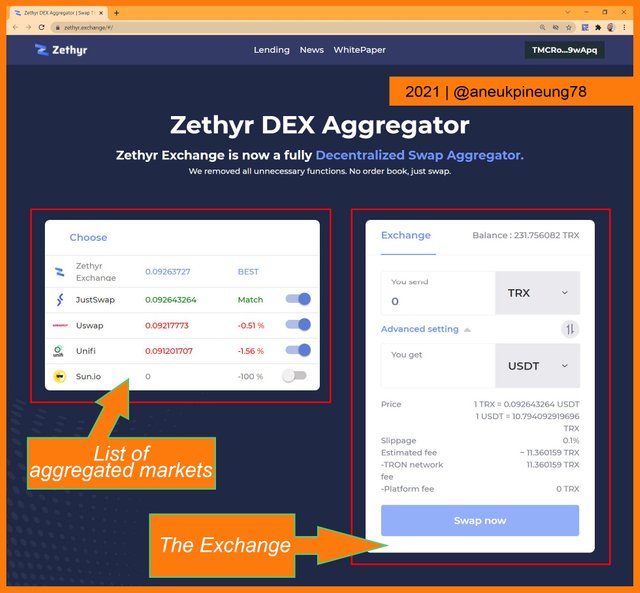

Task 3 - Zethyr Finance Markets Exploration
- I opened Zethyr Finance. And scrolled down to the Market segment as seen on the picture below.
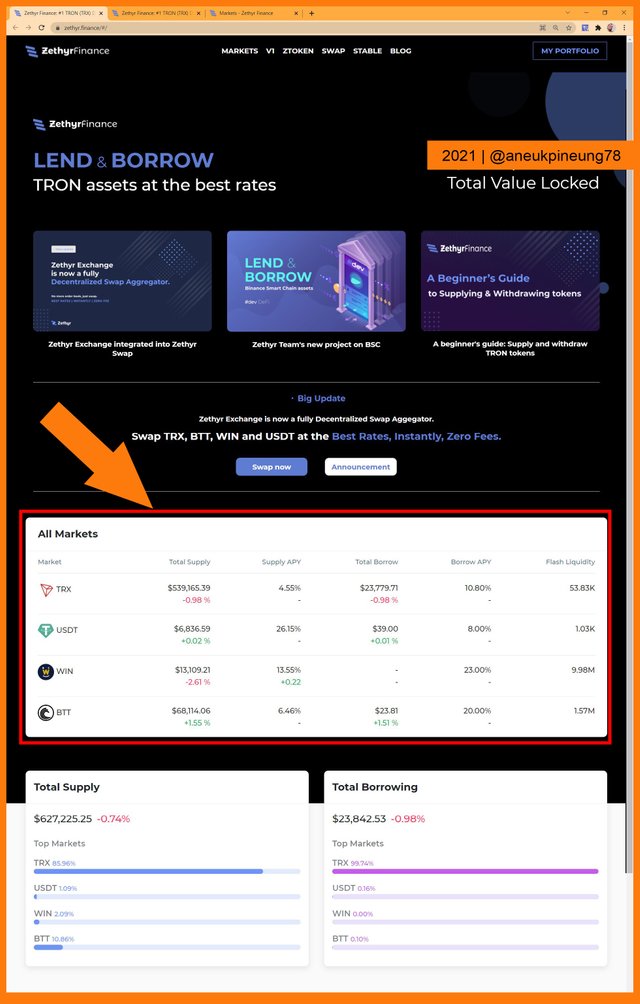
The Zethyr Finance homepage anatomy. - The Market segment showed that at time of writing, USDT offered the highest Supply APY and the lowest Borrow APY. Supply APY ranked from highest to lowest was: 1) USDT (26.15%), 2) WIN (13.70%), 3) BTT (6.46%), and 4) TRX (4.55%). While the Borrow APY ranked from the highest to lowest was: 1) WIN (23.00%), 2) BTT (20.00%), TRX (10.80%), 4) USDT (8.00%).
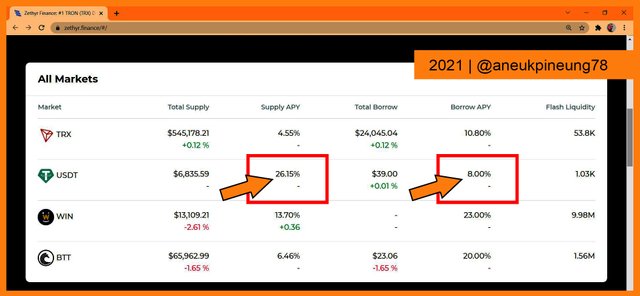
The market segment of the Zethyr Finance’s webpage.
The picture above shows us that, based on the APY, the borrowers would need to pay less if they borrowed USDT and the lender will make more profit by supplying to USDT. It is interesting to observe the chart that USDT, at time of writing, only had a total supply of 6,835.59, the lowest of all. The borrowed assets number was also the lowest, $39.00 (0.57% of its total Supply). USDT also put itself as the lowest Flash Liquidity asset at 1.03K.
The picture below shows us that TRX had the best performance both in borrowing and supply activity. It had the highest number in both total supply and total borrowing. TRX dominated more than 86% of market supply and almost 100% of the borrowing market.
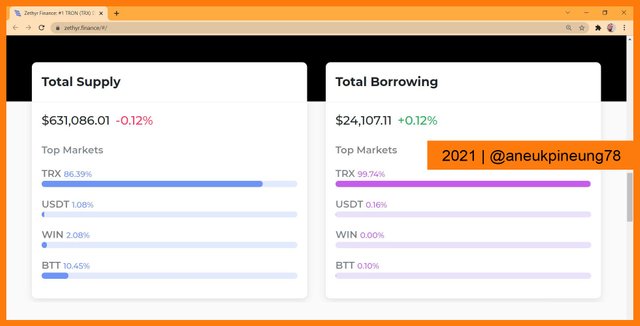
The total Supply and total Borrowing graph.

Task 4 - Connecting TronLink Wallet to Zethyr Finance
I performed this homework on a PC. I used Google Chrome web browser and its TronLink wallet extension. The steps I took to connect my TronLink Pro wallet to Zethyr Finance were:
- I opened the Zethyr Finance website on Google Chrome.
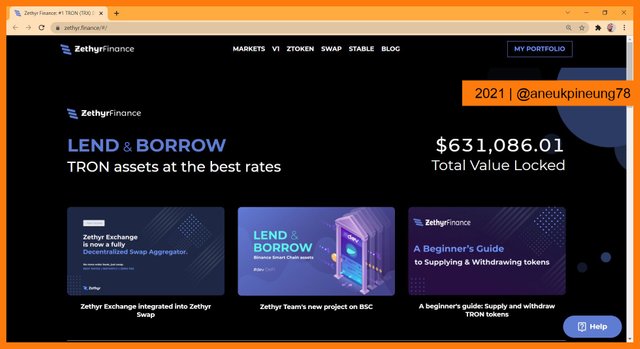
The Zethyr Finance homepage. - I activated the TronLink wallet extension on Google Chrome. I entered the password and clicked the [Continue] button.
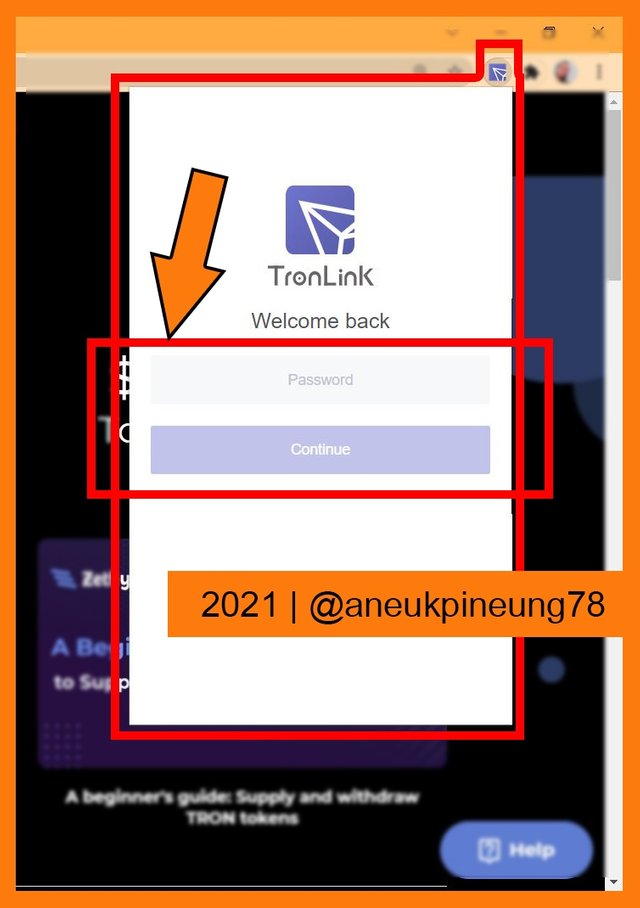
Logging in to TronLink wallet via Google Chrome’s extension. - A pop-up box appeared, asking for a confirmation to connect the wallet to Zethyr Finance. I clicked the [Connect] button.
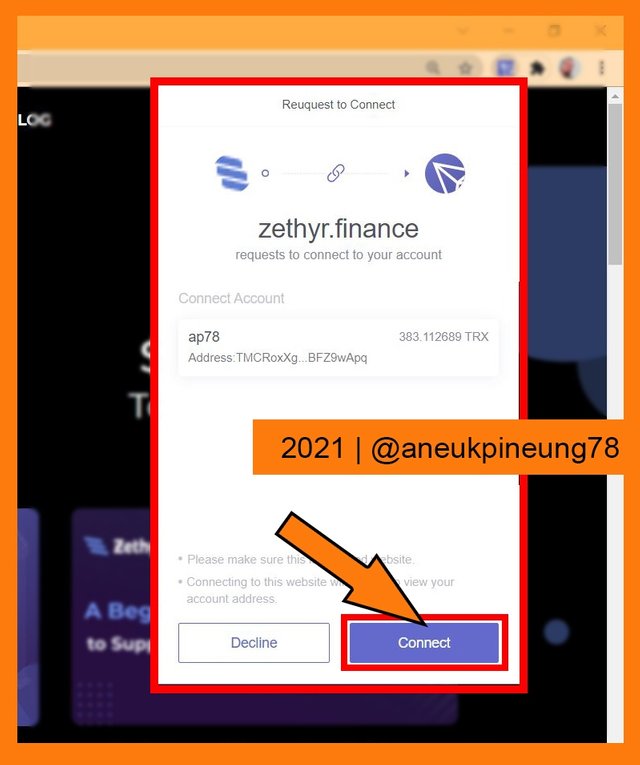
Confirming the connection. - And the connection was established right away.
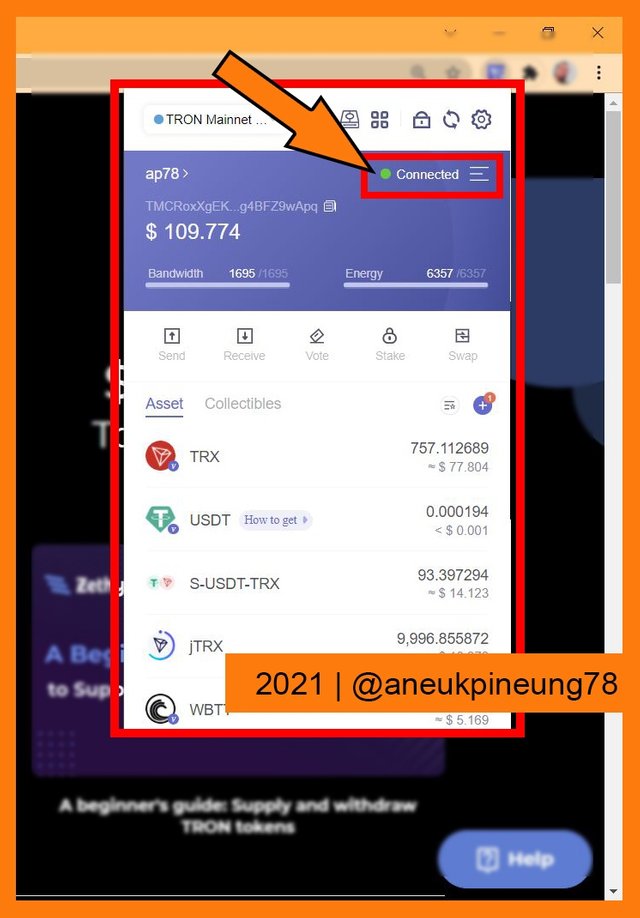
The TronLink wallet extension informing the success of the connection. - When I opened the DEX Aggregator page, it was displaying part of my TronLink wallet address as a sign that I the wallet had been connected to the dApp platform.
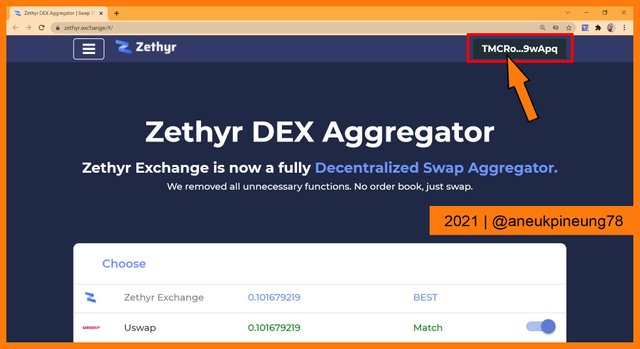
The Zethyr DEX Aggregator page confirmed the connection.

Task 5 - zTokens
When users supply their assets to Zethyr Finance, some amount of zTokens will be sent to their wallet, the amount of zToken received is proportional to the amount of supply, since it is pegged 1:1 to the value of the tokens supplied to the platform. For example: 10 TRX supply will get the supplier 10 zTRX.
zToken, like other tokens used in the TRON-based DEX platform, is made base on the TRC-20 standard. zToken holders can use it as collateral if they want to borrow a number of other tokens at Zethyr Finance.
Here comes a case study. I supplied 10 TRX to the platform.
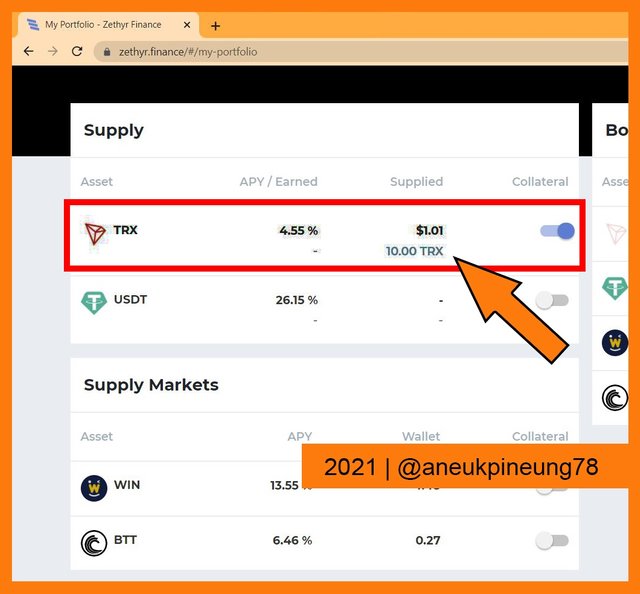
And I got 10 zTRX in my wallet. I can now collateralize it to borrow any tokens at the amount below its maximum borrowing limit.
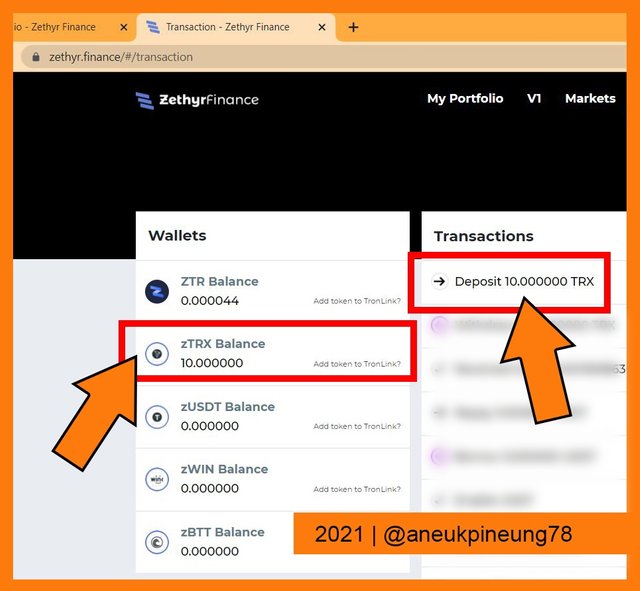
Below is the table of currently traded TRON assets on Zethyr Finance and their zToken symbos.
| Tokens | zTokens |
|---|---|
| TRX | zTRX |
| USDT | zUSDT |
| WIN | zWIN |
| BTT | zBTT |
Another tokens that serve the same purpose as zTokens do and function the same are jTokens, which are available on another TRON-based DEX platforms, JustLend. They are kind of special currencies of which by holding them users can enjoy the full benefits of their supplied assets (underlying tokens) without withdrawing their assets from the platform.

Task 6 - A Real Supply Transaction on Zethyr Finance
6.1. Supplying TRX to Zethyr Finance
To supply assets to Zethyr Finance, I went to the market segment of the dApp. I clicked on TRX symbol since I wanted to supply TRX. But later on I get to know that at this step, clicking on any symbol won’t be any different.
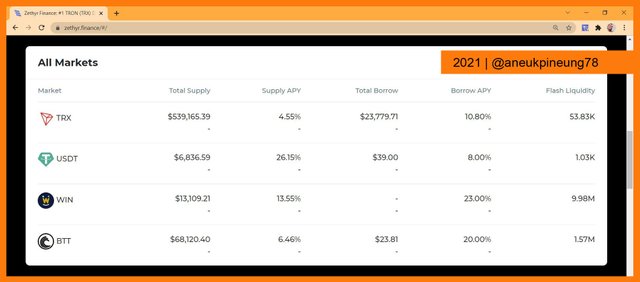
That brought me to My Portofolio page. The page showed two tables: 1) the Supply Markets which informed the available assets, their Supply APY, and the balance in the connected wallet; and 2) the Borrow Markets which contained information of available assets, their Borrow APY, the current borrowed assets (if any) made by connected wallet and each asset’s Flash Liquidity. I clicked on the TRX logo to supply.
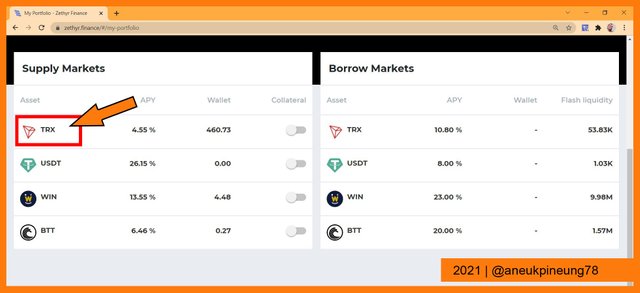
A pop-up box appeared. I made sure the Supply option was chosen (it was by default, by the way). And since I was new to the platform, I needed to enable the TRX supply. I clicked the [Enable] button.
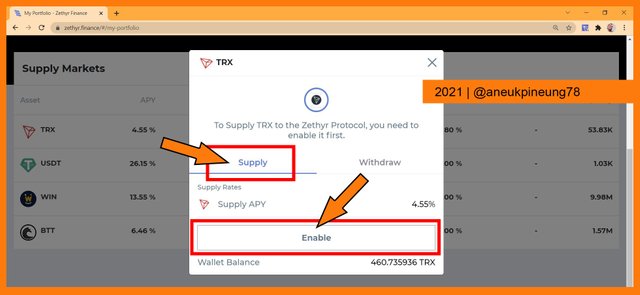
As we all know already that it needs some Bandwidth and Energy to perform any transaction on TRON ecosystem, so it seemed I had problem with Energy. 20 TRX were to be burn to accommodate the transaction’s need of Energy.
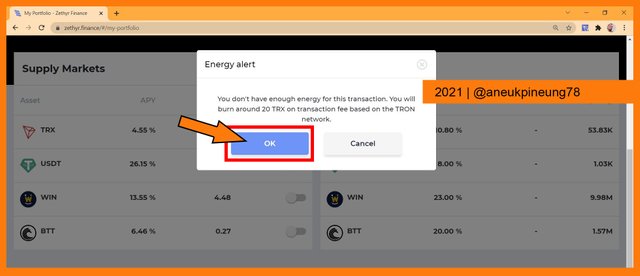
I opened the TronScan Resource page and staked 100 TRX in order to obtain more Energy.
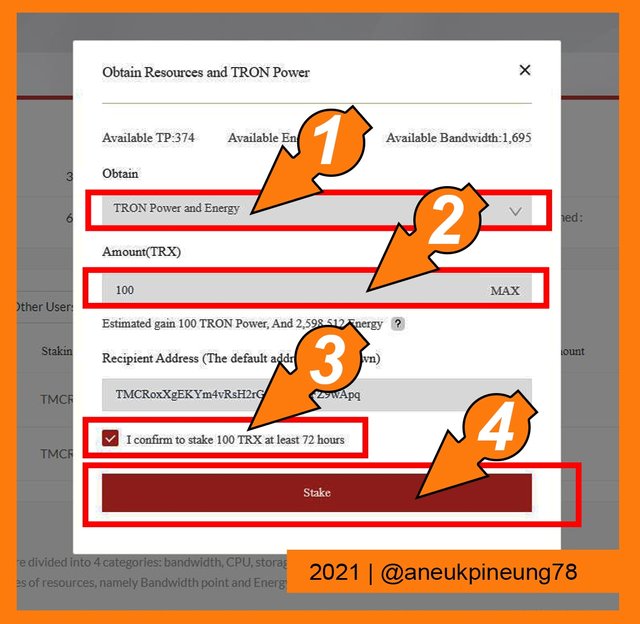
I went back to the My Portfolio page on the Zethyr Finance website and hit the [Enable] button.
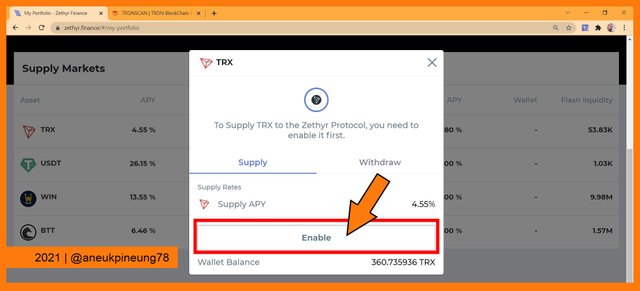
I still saw the Energy alert pop-up box, maybe I did not burn enough TRX. I decided to proceed as it was. I clicked the [OK] button to proceed.
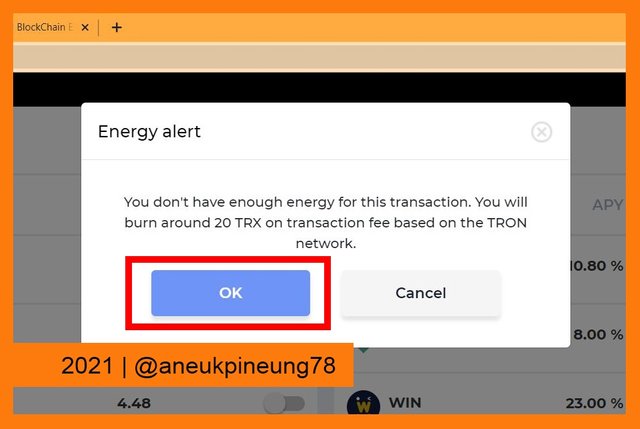
The fee it took for enabling TRX was 14.43442 TRX. It needed the wallet signing to proceed furthermore. I clicked the [Sign] button.
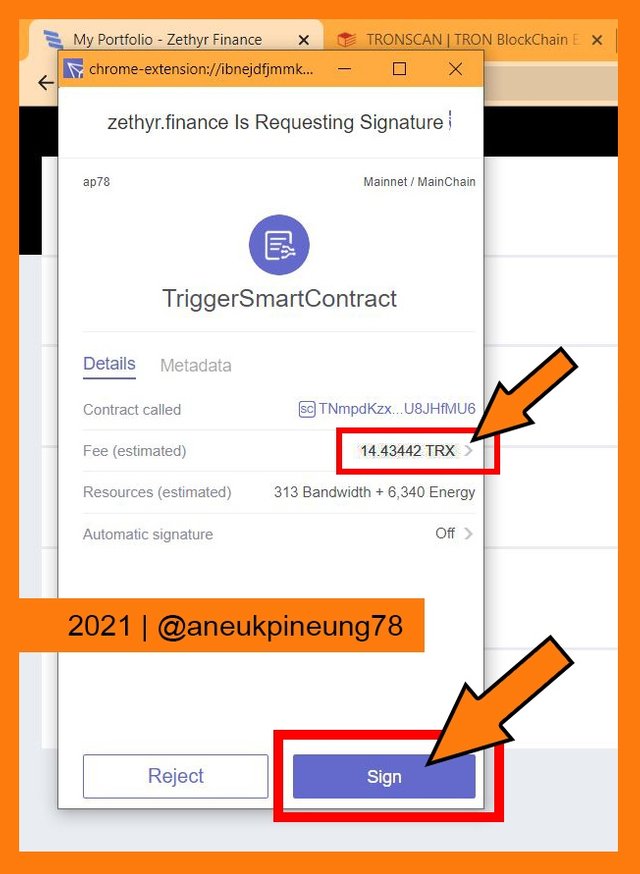
Now I had TRX enabled for supply. The transaction details can be viewed on TronScan here. So, I clicked on it.
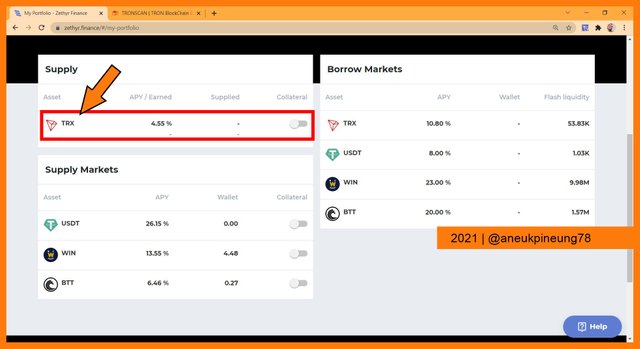
A pop-up box appeared where I needed to fill in the credential data of the supply I wanted to make. The minimum TRX supply requirement was 10 TRX. I decided to supply 100 TRX.
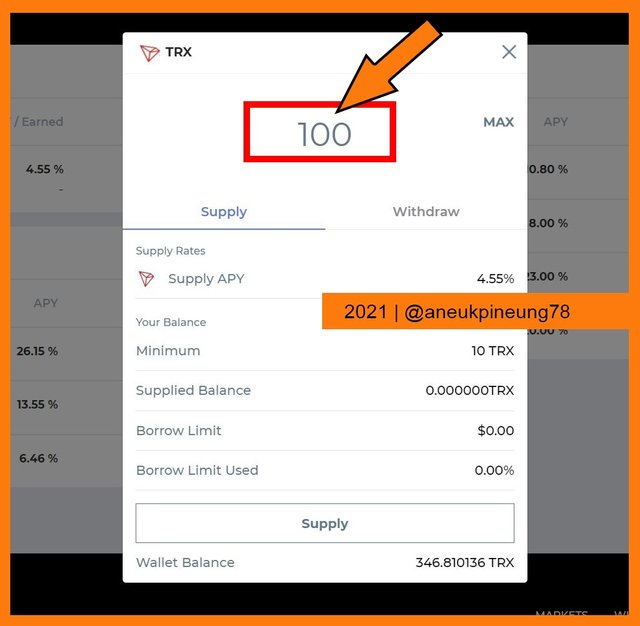
Energy alert again. It was understandable, actually. I hit the blue [OK] button.
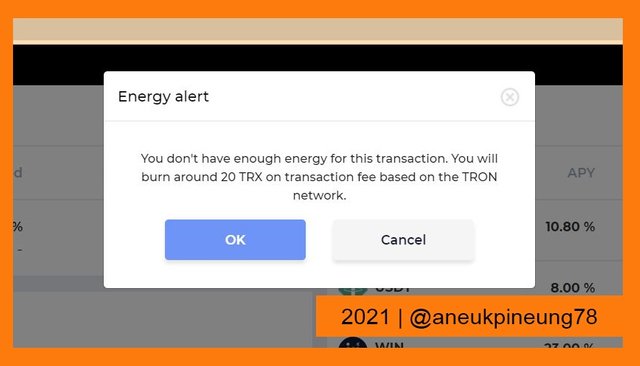
Supplying 100 TRX needed fee as much as 14.74284 TRX. Zethyr Finance needed the wallet approval. I clicked the [Sign] button.
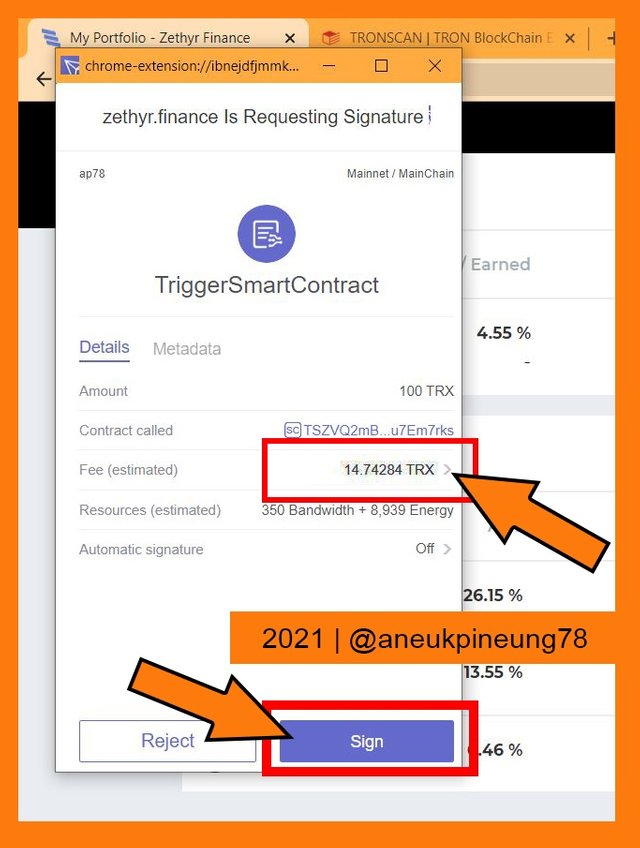
I successfully supplied 100 TRX to Zethyr Finance. The details of the transaction can be viewed on TronScan here.
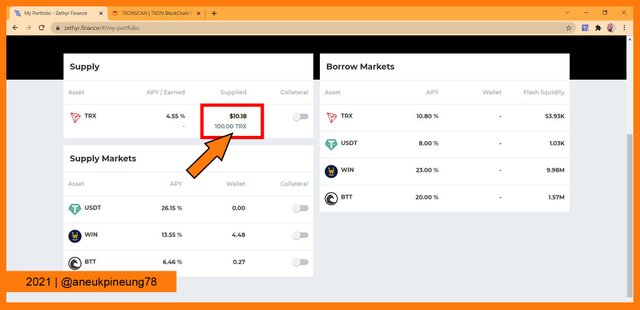
Below is the screenshot image of the overall interface of the My Portfolio on Zethyr Finance.
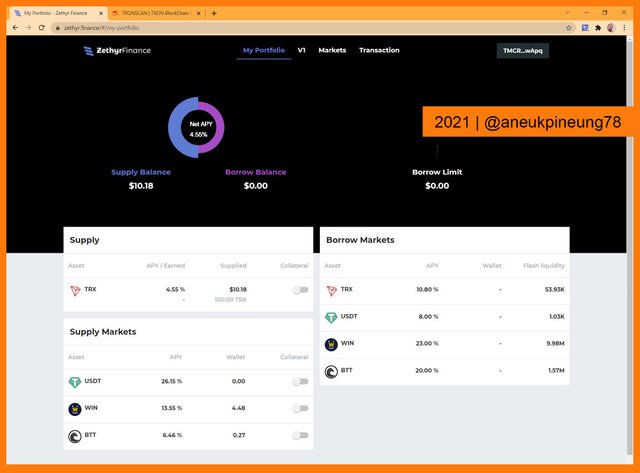
The picture above shows that my Supply Balance was USD10.18, USD0.00 Borrow Balance. And USD0.00 Borrow Limit. The explanation is:
- Supply Balance is USD equivalent of the total supply a user made. In this case I supplied 100 TRX which was equivalent to USD10.18 at time of writing;
- Borrow Balance is total amount of “active” borrow an account has made in term of USD equivalent;
- Borrow Limit is the total limit in term of USD equivalent a user can make, in accordance to their total collateralized assets. In this case, no assets of mine was collateralized, so I had no Borrow Limit at this point.
6.2. Fee Paid (Resources Used) in the Process of Supplying TRX to Zethyr Finance
In the process of supplying TRX to Zethyr Finance, I performed three transactions:
- Staking 100 TRX to get additional energy. Details of this transactions can be seen on TronScan at this page.
- Enabling TRX. Details of this transactions can be seen on TronScan at this page.
- Supplying 100 TRX to Zethyr Finance. Details of this transactions can be seen on TronScan at this page.
Below is the table of fee paid (Bandwidth and Energy used) for the three transactions.
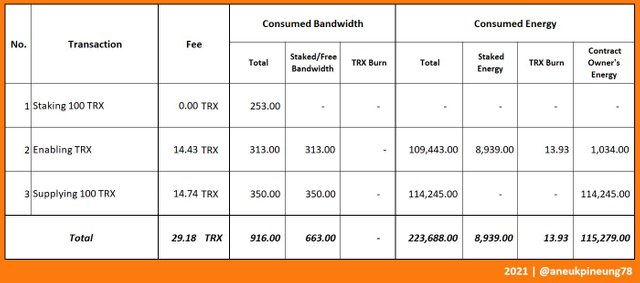
In total, I used 129.18 TRX in completing task 6.

Task 7 – Collateralizing, Borrowing, Repaying, and Withdrawing Supply on Zethyr Finance
7.1. Collateralizing Assets
To collateralize my supply (TRX), I simply clicked the collateral button to activate it.
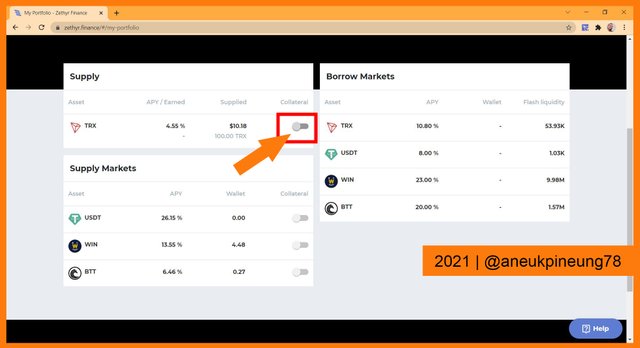
A pop-up appeared, asking for confirmation. I clicked the [Use TRX as collateral] button.
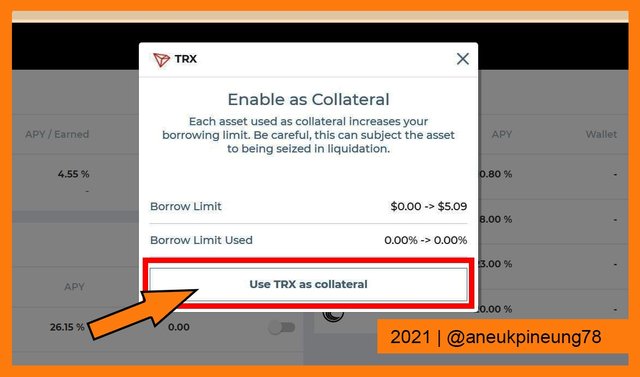
Another Energy alert. I clicked the blue button.
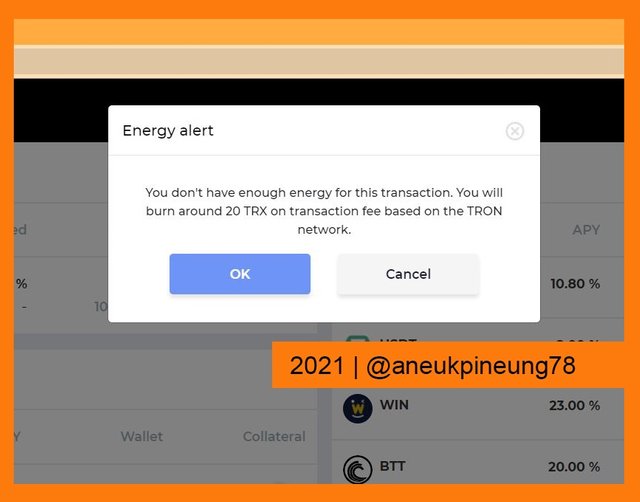
Fee for collateralizing 100 zTRX was 6.97214 TRX. The platform needed the wallet signature. I signed it.
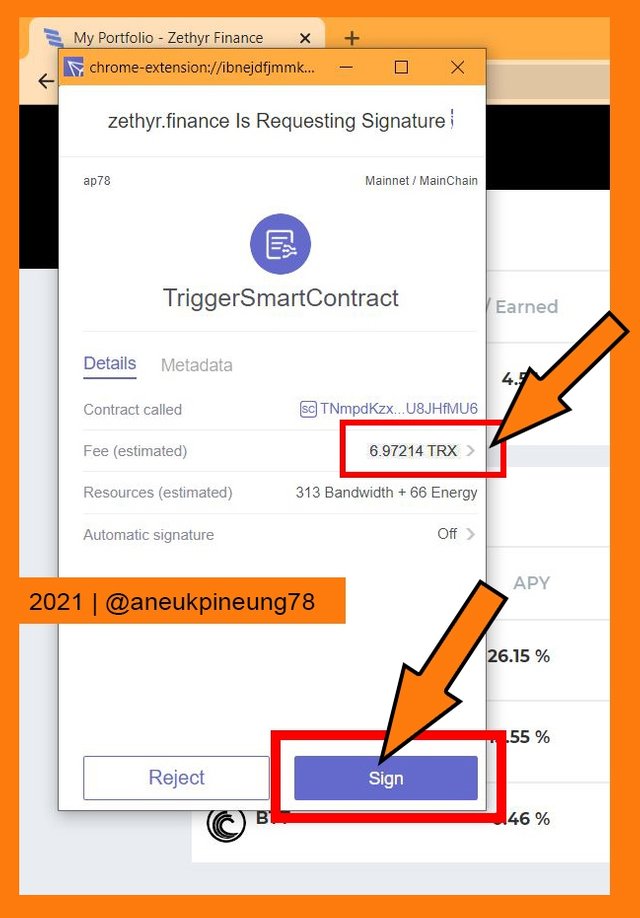
The collateralizing process was a success.
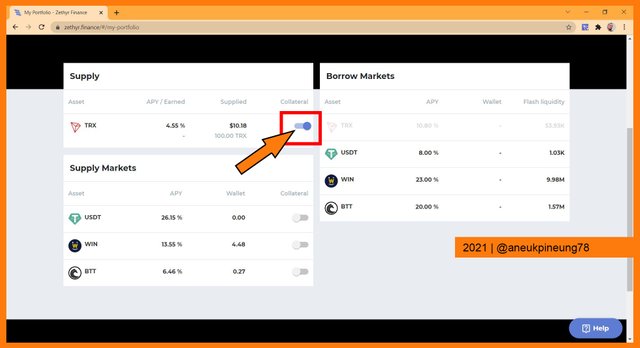
The transaction details can be seen on TronScan at this page. It consumed 313 Bandwidth (free) and 128 Staked Energy. It also burnt 6.93658 TRX for 49,547 Energy and consumed 192 of Contract Owner’s Energy .
7.2. Borrowing Assets
I wanted to borrow some USDT. So, on the Borrow Markets table on the My Portfolio page I hit somewhere along the USDT line.
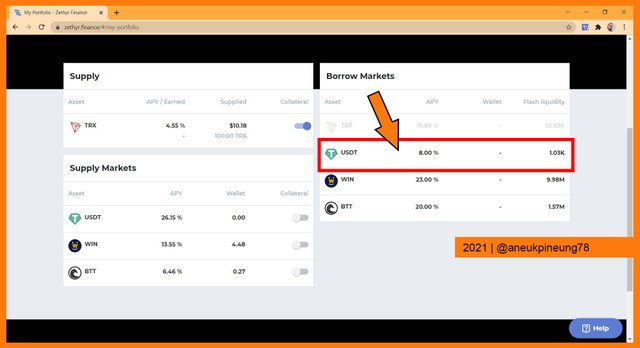
Before the borrowing can be done, the assets to borrow needs to be enabled first. So on the pop-up menu that appeared I clicked the [Enable] button.
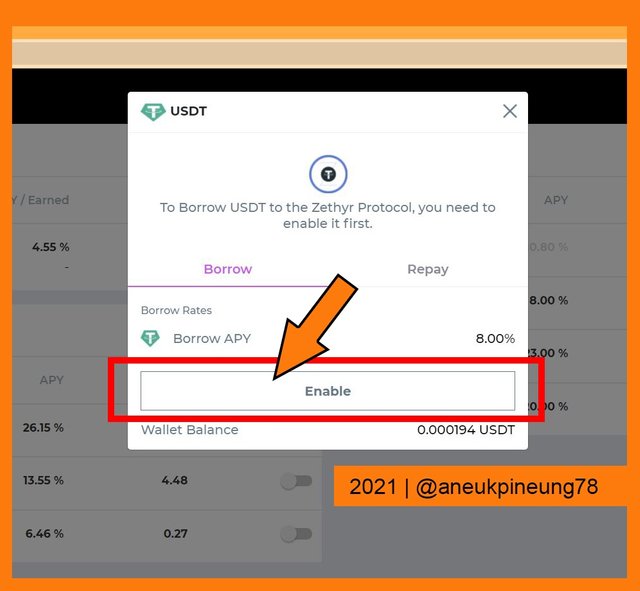
Another Energy alert. Expected it.
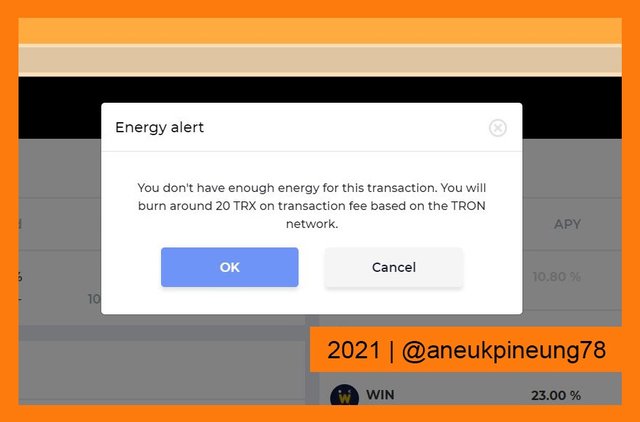
Enabling USDT took 12.33484 TRX fee. I signed the wallet again to proceed.
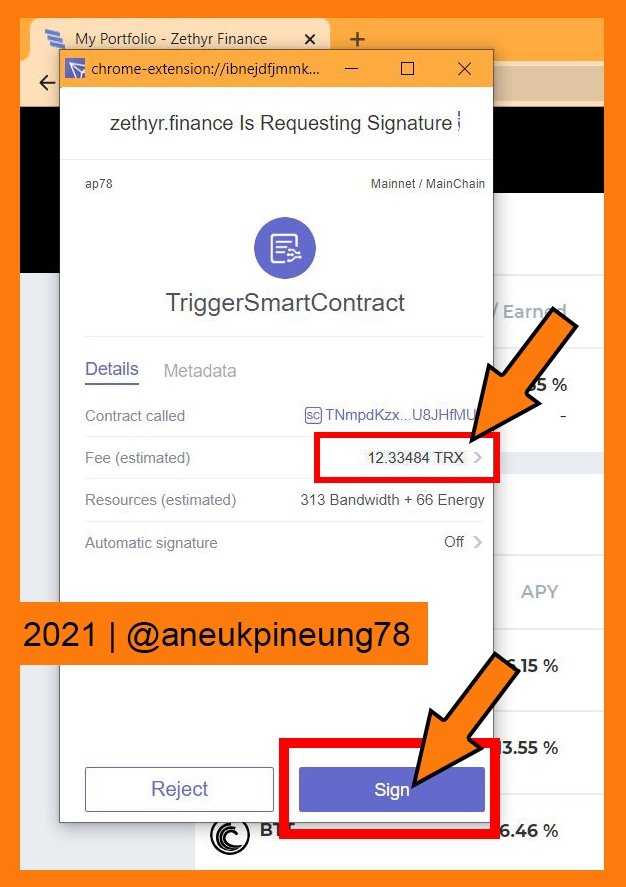
The USDT enabling was a success. The details of the transaction can be viewed on TronScan at this page. It consumed 313 Bandwidth (burnt 0.313 TRX for 313 Bandwidth), 88,172 Energy (38 staked Energy + 55 Contract Owner’s Energy + Burned 12.33106 TRX for 88,079 Energy).
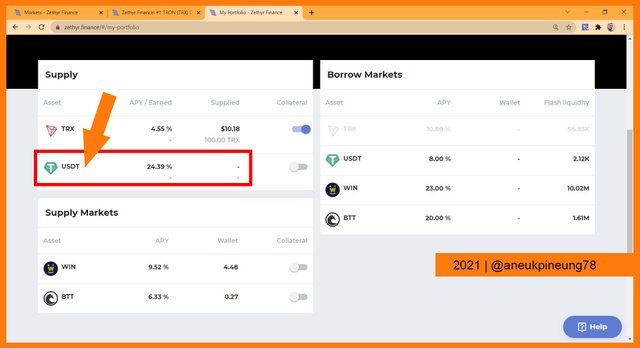
Time to proceed to borrowing USDT. I clicked inside the USDT line on the Borrow Markets table.
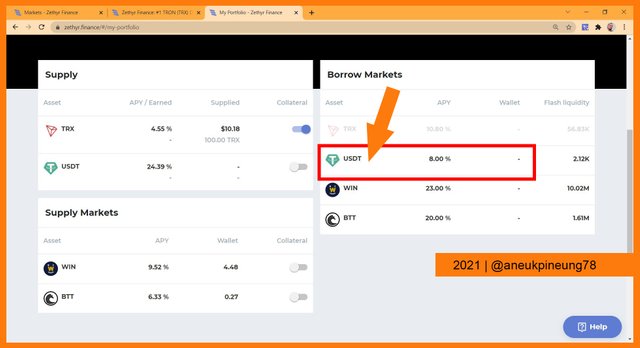
The popped-up box showed that the maximum borrow I was able to make was 5 USDT (equivalent to USD5.00). It is 50% of the asset I collateralized in term of USD equivalent (USD10.18). I borrowed 3 USDT for this experiment purpose.
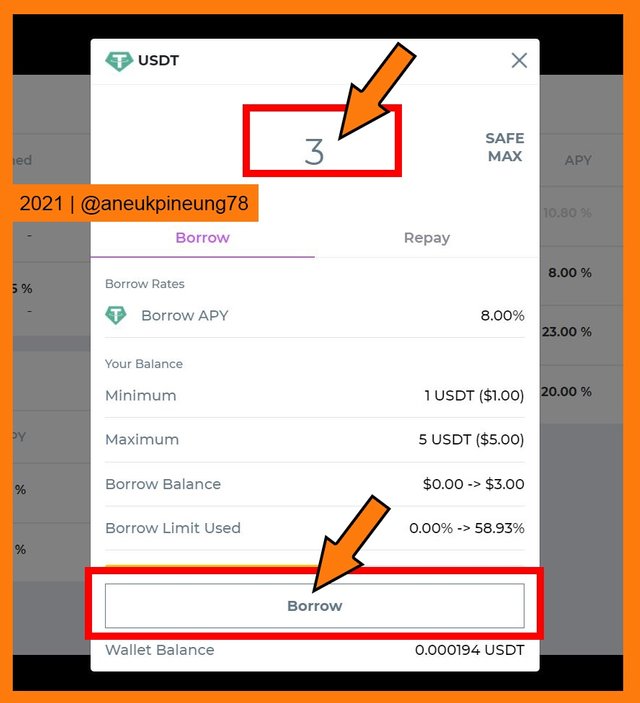
Energy alert. I clicked the [OK] button, for sure.
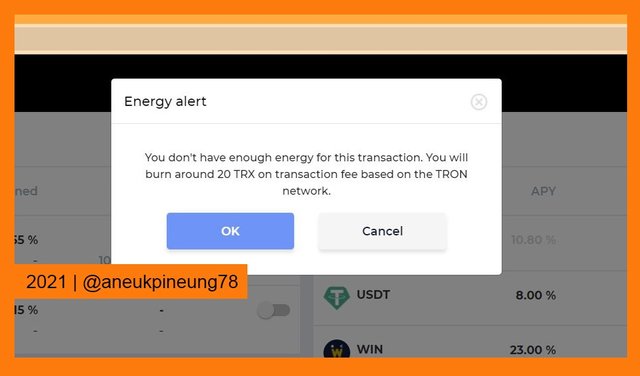
Fee for borrowing 3 USDT was 23.29348 TRX. I confirmed by signing the wallet.
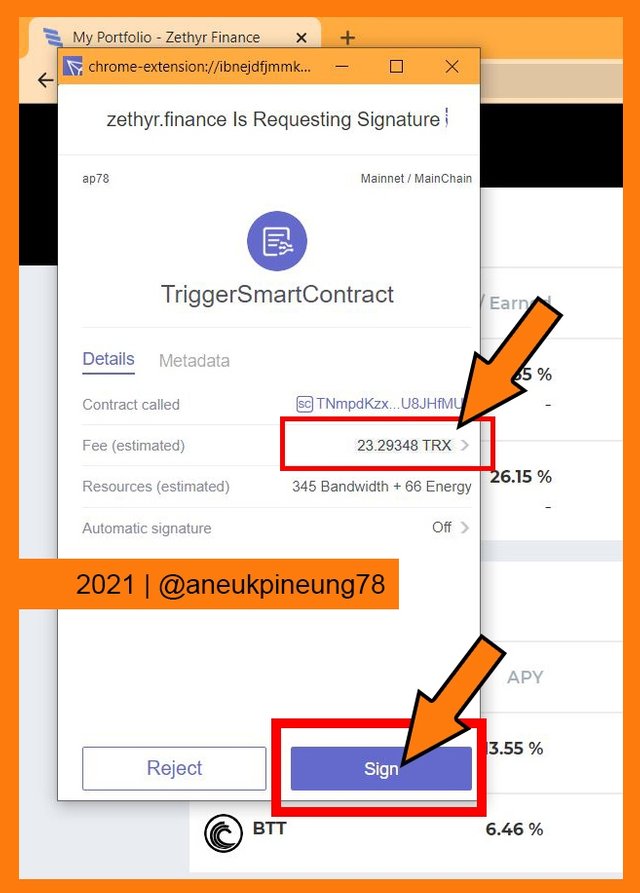
The borrowing was successful.
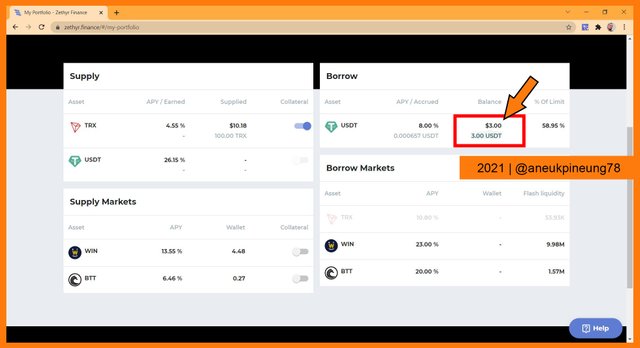
The transaction details can be seen on TronScan at this page. It consumed 435 Bandwidth (burned 0.345 TRX for 345 Bandwidth) and 166,448 Energy (22 staked Energy + 33 contract owner’s Energy + Burn 23.29502 TRX for 166,393 Energy).
7.3. Repaying the Borrowed Assets
To repay the borrowed asset, user can simply start by clicking on the asset to repay on the Borrow list (above the Borrow Markets table on Market segment of the Zethyr Finance website). In this experiment I had USDT to repay, so I clicked on it.
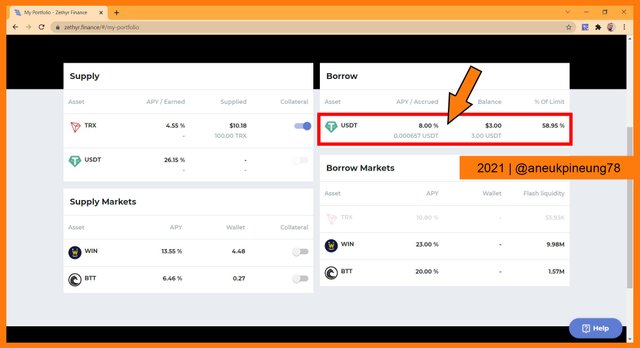
On the popped box, I made sure the Repay option was chosen (marked by number (1) on the picture below). Since I wanted to repay all, I clicked the [MAX] button (marked by number (2)). The amount I needed to pay (the sum of borrowed amount and its interest) automatically filled in (marked by number (2a)). Lastly, I hit the [Repay] button.
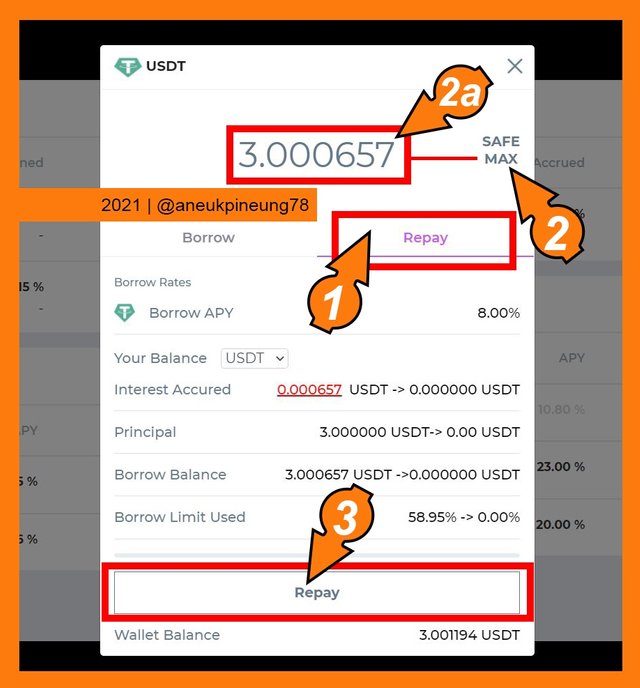
Energy alert.
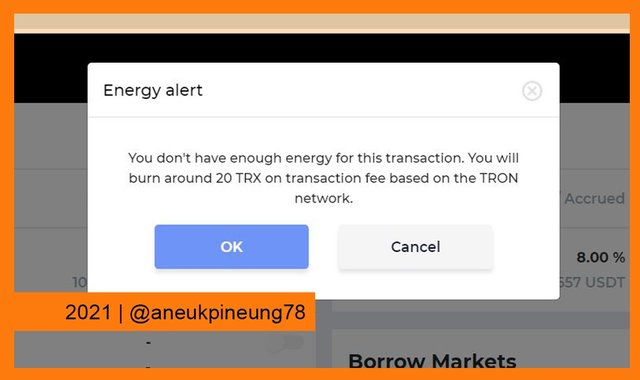
Zethyr Finance asked confirmation to give approval for the transaction. Since it involved another party to conduct the transaction on their half and it needed the approval on my half. It took a fee at 3.17282 TRX. I approved.
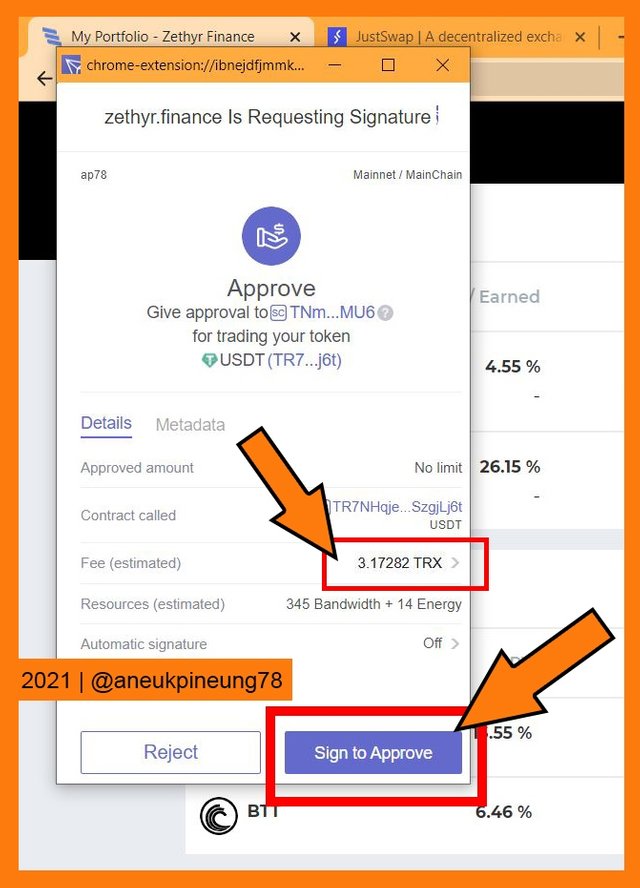
The trade approval details can be seen on TronScan at this page. It consumed 345 Bandwidth (burned 0.345 TRX 345 Bandwidth) and 22,677 Energy (21 staked Energy + 0 contract ownr’s Energy + burned 3.17184 TRX for 22,656 Energy.
Zethyr Finance needed another wallet approval. This time for repaying process. The fee was 48.4036 TRX. I clicked the [Sign] button.
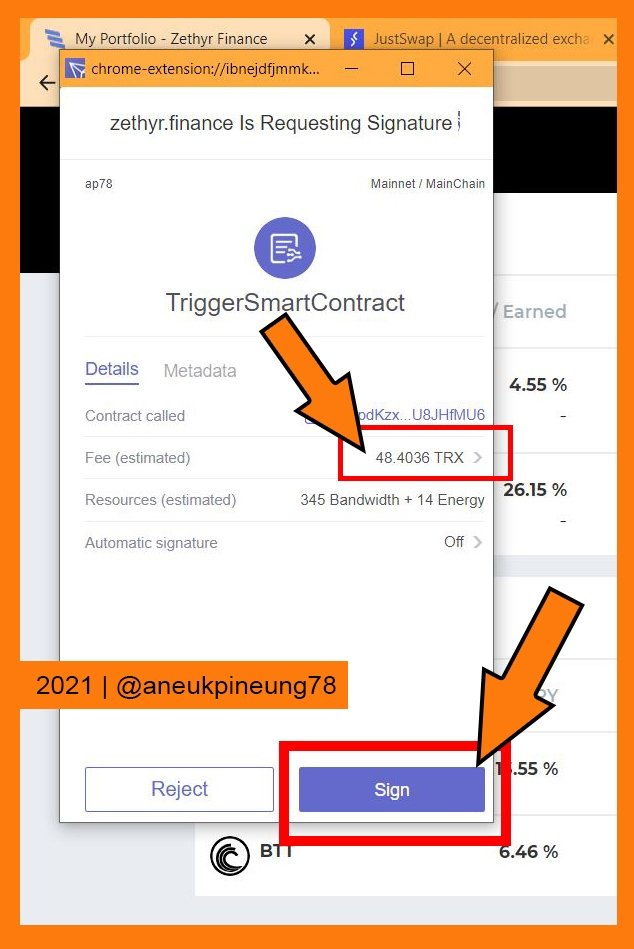
The repay process was a success.
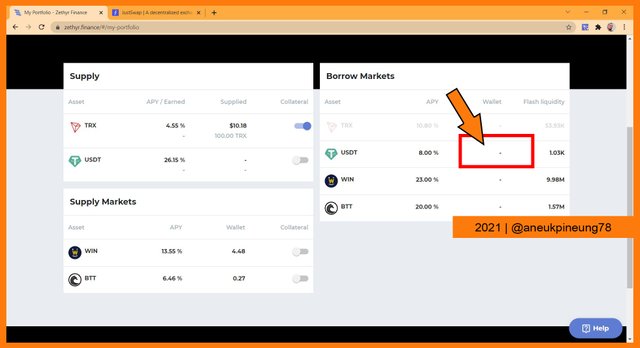
The details of the repay transaction can be viewed on TronScan here. It consumed 345 Bandwidth (Burned 0.345 TRX for 345 Bandwidth) and 345,754 Energy (3 Staked Enerrgy + 107 contract owner’s Energy + Burn 48.39016 TRX for 345,644 Energy).
7.4. Withdrawing Supply
I started the process of withdrawing my TRX supply from Zethyr Finance by clicking on the TRX in Supply list (above Supply Markets on the market segment of the platform’s My Portfolio page).
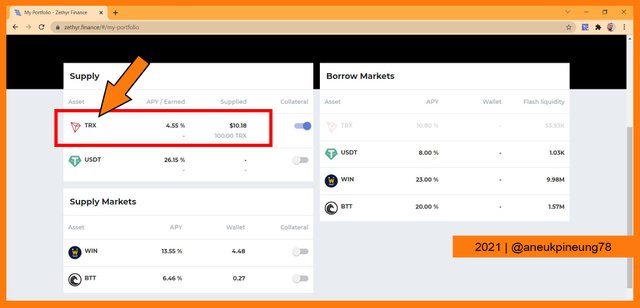
On the pop-up box, I clicked the Withdraw option (marked by number (1) on the picture below). I hit the [MAX] button (marked by number (2)), since I wanted to withdraw all the supplied TRX. And lastly I hit the [Withdraw] button (marked by number (3)).
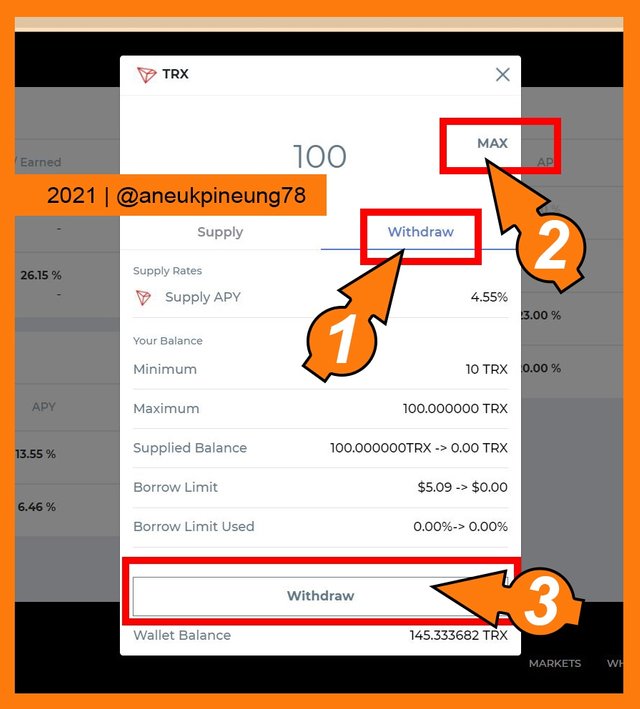
Energy alert. As expected.
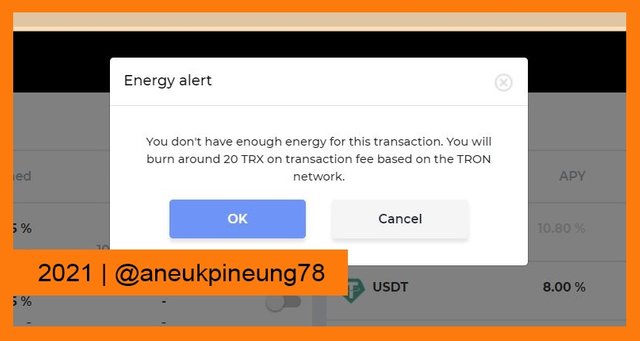
Fee for withdrawing 100 TRX was 13.43356 TRX. I signed the wallet to approve it.
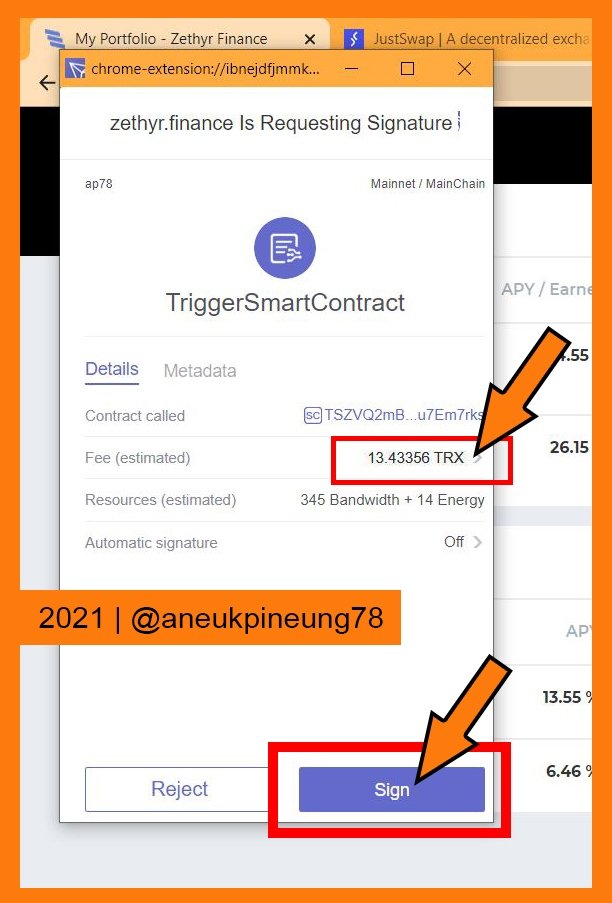
The picture below shows that the withdrawal was successfully made.
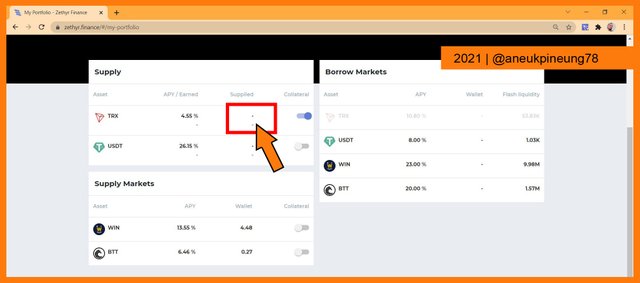
The withdrawal transaction details can be seen on TronScan here. It consumed 345 Bandwidth (burned 0.345 TRX for 345 Bandwidth) and 95,968 Energy ( 0 user's staked energy + 95,968 contract owner's Energy + burned 0 TRX)
7.5. Summary
In task 7, I performed six transactions:
- Collateralizing 100 zTRX. The details can be seen on TronScan at this page.
- Enabling USDT. The details can be seen on TronScan at this page.
- Borrowing 3 USDT. The details can be seen on TronScan at this page.
- Trade Approval for Repaying. The details can be seen on TronScan at this page.
- Repaying. The details can be seen on TronScan at this page.
- Withdrawing. The details can be seen on TronScan at this page.
Total fee paid for completing Task 7 was 107.61 TRX. Below is the detailed table of the paid fee (consumed Bandwidth and Energy).
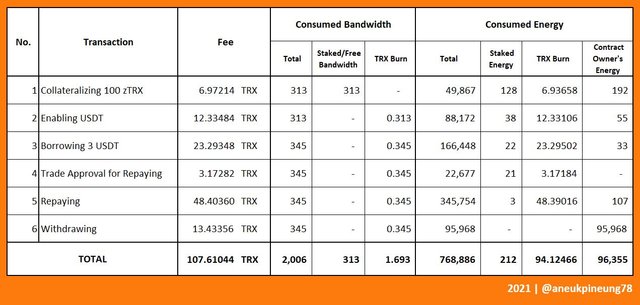

Task 8 – My Opinion on Zethyr Finance
Zethyr Finance, as a lending and borrowing protocol for TRON assets, is actually not a new thing in the world of decentralized exchange, nor is it new on the TRON ecosystem. In general, Zethyr Finance's workflow is exactly the same as JustLend's workflow. The difference between the two may be lie in the interfaces, but I will not compare the two, because interface is likely subject to personal taste. Another difference is in the Borrow and Supply APY rates, and the number of TRON assets available for borrow and accepted for supply. At time of writing, on Zethyr Finance (lending and borrowing protocol) 4 types of TRON assets are available and accepted, while JustLend supports no less than 12 TRON assets, but this is understandable since Zethyr Finance is still "very young", we can expect for more in the future.
If we talk about Zethyr Finance as a lending and borrowing protocol, until now I don't see anything unique about this dApp. This dApp might be a consideration for dApp users to get more profitable Borrow APY and Supply APY (if any). Without that or the other innovations that make it special, I think people would prefer JustLend, for example, because of its support for more TRON assets for one reason. Below is the comparison table of supported assets on Zethyr Finance and JustLend, as per time of writing data.
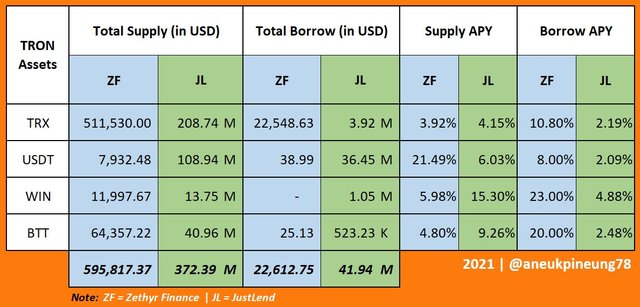
The comparison chart of Supply and Borrow APY rate of mutually supported TRON assets on Zethyr Finance and JustLend are as follow.
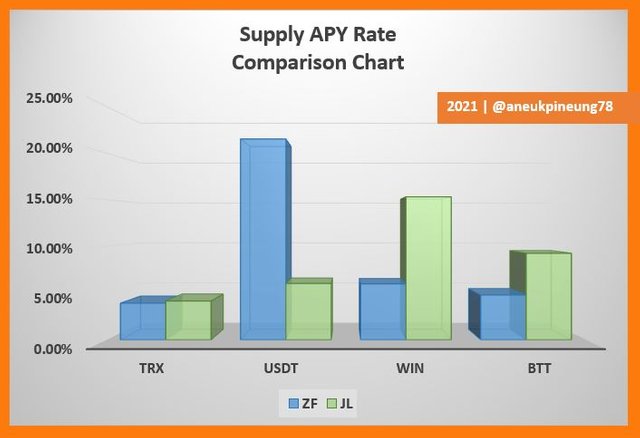
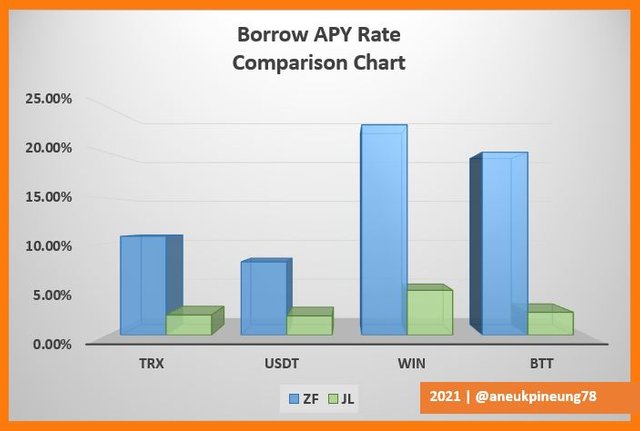
But when talking about Zethyr Finance as a dApp that enriches the TRON ecosystem, I see this as something positive, with the hope -of course- that this dApp will support more TRON assets and perhaps bring some unique innovations.
If we talk about Zethyr Finance as part of the technology produced by the Zethyr Team, this is a great addition to other technologies of their invention such as Swap on Zethyr Exchange which has adopted DEX Aggregator technology, or Stable Swap which allows users to convert their TRC-20 USDT tokens to ERC-20 type of USDT.
But, still, in my opinion, as a lending and borrowing protocol, Zethyr Finance still has many things to do to at least match the level of similar protocols that currently exist on the TRON ecosystem.

Thanks
Thanks Professor @fredquantum for the lesson titled Zethyr Finance.
Pictures Sourcing
- The editorial picture was created by me.
- Unless otherwise stated, all another pictures were screenshoots and were edited with Photoshop CS 3.
Sources and Reading Suggestion
- https://steemit.com/hive-108451/@fredquantum/steemit-crypto-academy-season-4-week-8-advanced-course-or-zethyr-finance;
- https://www.bitdegree.org/crypto-tracker/top-tron-dapps/zethyr-finance;
- https://medium.com/@zethyrexchange/zethyr-finance-strategy-guide-b66141b26a67;
- https://dapp.review/dapp/Zethyr-Finance;
- https://www.dapp.com/app/zethyr-lending;
- https://medium.com/@zethyrexchange/zethyr-finance-2-migration-from-zethyr-finance-1-d9473947d392;
- https://medium.com/@zethyrexchange/zethyr-finance-2-lending-pools-40f743853475;
- https://blog.zethyr.exchange/guide-how-to-supply-withdraw-on-zethyr-fi/;
- https://blog.zethyr.exchange/zethyr-exchange-integrated-into-zethyr-swap/;
- https://dapponline.io/dapp-detail/3914?invite=uvu7jf&time=1613214373401;




Shared to Twitter: https://twitter.com/aneukpineung78a/status/1454317886411993097.
#club5050 😀